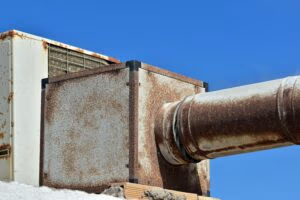What’s the Best Way to Heat a Commercial Warehouse?
What’s the best way to heat a commercial warehouse in New Jersey? It’s a question lots of people are asking now.
In case you haven’t noticed, the New Jersey / South Philly area is packed with large warehouses.
Ever wondered why?
Location. Location. Location!
New Jersey lies between Philadelphia, Washington, D.C., Boston, and New York City. We’ve got the largest seaport on the East Coast, dozens of major highways, and an existing workforce of distribution, logistics, and transportation professionals.
In 2021, 13.9 million square feet of NEW warehouse space was being constructed in New Jersey.
So it’s no surprise that a lot of people are asking, “What’s the best way to heat a commercial warehouse?”
Keeping products and workers warm is important!
In the bustling industrial areas of New Jersey and South Philadelphia, commercial warehouse owners face a critical decision when it comes to keeping their spaces warm and functional during the colder months. Winters in this region can be unforgiving, making it essential to choose the right heating method. January and February are the coldest months, with nightly temps falling into the teens and twenties. Daytime highs hover in the upper 30s to the low 40s. Those conditions produce lots of snow and ice storms.
Products must be kept at certain temperature levels, and workers must be warm enough to work without fear of frostbite!
Different Ways to Heat a Commercial Warehouse
Commercial warehouses in the New Jersey and South Philadelphia area have several options for heating, with radiant heating and hot air heating being the primary contenders.
Radiant Heating:
Radiant heating systems work when a series of radiant tubes or panels are installed in the floors or on the walls of the warehouse. These tubes or panels are heated by either water or electricity, and that heat goes out via infrared radiation, directly heating objects and surfaces. Radiant heating is known for its efficiency in maintaining consistent temperatures.
Hot Air Heating:
Hot air heating relies on forced air systems that distribute warm air throughout the warehouse via vents and ducts. Furnaces or heaters generate hot air, which is then circulated to raise the indoor temperature.
Pros and Cons of Radiant Heating:
Radiant Heating has lots of positive aspects.
- Offers even and consistent heating, reducing temperature fluctuations.
- Energy-efficient by directly heating objects and surfaces, minimizing heat loss.
- Operates silently, creating a more comfortable working environment.
- Reduces dust circulation, improving air quality.
But radiant heating has a few drawbacks.
- Initial installation costs can be higher than hot air systems.
- May have a slightly slower warm-up time compared to hot air heating.
- Limited capability to provide cooling during the summer months.
Pros and Cons of Hot Air Heating:
Hot air heating systems also have many pros.
- Provide rapid warm-up times, ideal for warehouses with frequent temperature changes.
- Generally comes with lower initial installation costs compared to radiant heating.
- Can be adapted for cooling purposes with the right system.
- Easier to zone and control the temperature in specific areas.
But nothing good is ever perfect. Hot air heating has these issues:
- Slightly less energy-efficient than radiant heat due to potential heat loss through ducts and vents.
- Temperature fluctuations can occur, resulting in uneven heating.
- Noise from fans and blowers may be disruptive.
Most Common Heating Methods in New Jersey and South Philadelphia:
In the New Jersey and South Philadelphia areas, hot air heating is the most common choice for commercial warehouses. The need for quick warm-up times, especially when dealing with rapidly changing weather conditions, makes hot air heating the preferred option. However, some warehouse owners in this region are also exploring radiant heating systems, particularly for larger spaces or those requiring precise temperature control.
Cost-Effectiveness:
Determining the most cost-effective heating solution for your commercial warehouse in the New Jersey and South Philadelphia area involves considering various factors, including initial installation costs, energy efficiency, maintenance, and long-term operational expenses.
It also involves getting expert help from Elite Heating and Air Conditioning, so that we can understand the purpose of your building, the size, location, and layout and help you make the best decision possible.
Radiant heating may have higher upfront costs, but its energy efficiency can lead to lower ongoing operational expenses. In contrast, hot air heating systems are generally more affordable to install but may have slightly higher ongoing energy costs due to potential heat loss.
Elite can help you figure out the best way to heat a commercial warehouse in the New Jersey area
In the dynamic industrial landscape of the New Jersey and South Philadelphia area, selecting the right heating system for your commercial warehouse is crucial for maintaining productivity during the cold seasons. Your decision should align with your warehouse’s unique needs, budget, and long-term objectives.
Whether you opt for radiant panels or hot air ducts, we can help you ensure your choice meets the specific requirements of your warehouse to create a comfortable and cost-effective environment for your business.
Elite has more than twenty-five years of experience in the commercial heating and air conditioning industry. Call us. We can keep your warehouse, your medical facility, your factory, or your retail space at whatever temperature you want it!

- best heating for warehouses, commercial HVAC systems, commercial warehouses, Elite Heating and Air Conditioning, Elite HVAC, Elite HVAC of South Jersey, energy-efficient warehouse heating, heating system installation, HVAC for warehouses, HVAC tips for warehouses, industrial heating, South Jersey HVAC services, warehouse heating solutions


